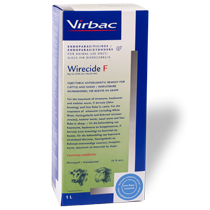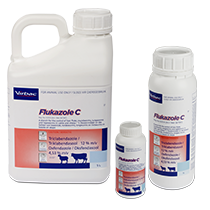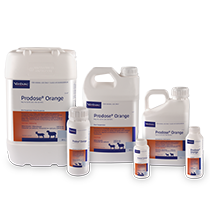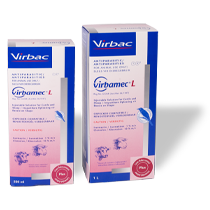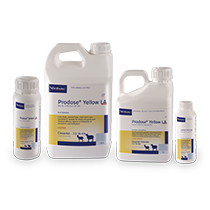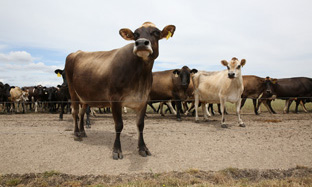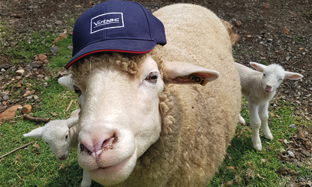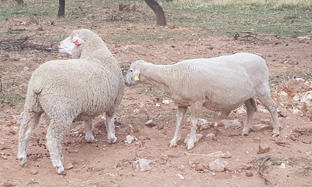
Worms
Wirecide F
Injectable anthelmintic remedy for cattle and sheep. For the treatment of wireworm, hookworm, nodular worm, Parafilaria bovicola (false bruising) and liver fluke in cattle. For the treatment of wireworm (including Whiteriver, Nooitgedacht and Kokstad resistant strains), nodular worm, nasal worm and liver fluke in sheep.
FOR ANIMAL USE ONLY
CAUTION
CHEMICAL GROUP: ⑤†
† Nitrophenols
COMPOSITION:
Nitroxynil 34 % m/v
DIRECTIONS FOR USE: Use only as directed
Cattle:
SUBCUTANEOUS INJECTION ONLY. Intravenous and intramuscular injection can cause irritation.
Standard dose
- Liver fluke and roundworms other than Parafilaria: Treat at the rate of 1,5 ml/50 kg body mass (± equivalent to 10 mg active ingredient per kg body mass).
Double dose
- Parafilaria bovicola (false bruising): Treatment consists of 1 injection of 3 ml of Wirecide F per 50 kg body mass (± equivalent to 20 mg active ingredient per kg body mass). Treat slaughter stock at least 70 days before marketing.
- If the total dosage exceeds 10 ml, inject in more than one site and massage thoroughly.
Dosage: Cattle
|
Body mass |
Liver fluke and roundworms Standard dose (10 mg/kg) |
Parafllaria Double dose (20 mg/kg) |
|
50 kg |
1,5 ml |
3 ml |
|
150 kg |
4,5 ml |
9 ml |
|
300 kg |
9,0 ml |
18 ml |
Sheep:
SUBCUTANEOUS INJECTION ONLY.
Intravenous and intramuscular injection can cause irritation.
Liver fluke, wireworm and nasal worm
Treat at the rate of 1 ml Wirecide F per 25 kg body mass (± equivalent to 13,6 g active ingredient per kg body mass).
Dosage: Sheep
|
Body mass (kg) |
Standard dose (ml) |
|
15 |
0,6 |
|
20 |
0,8 |
|
25 |
1,0 |
|
50 |
2,0 |
|
60 |
2,4 |
TREATMENT GUIDE
Liver fluke outbreaks
Early recognition of outbreaks is important and it is essential to give each animal in the herd an injection of Wirecide F without delay. However, see warning with reference to milking cows. When re-infestation is occurring, repeat the treatment with 8 weekly intervals.
Routine preventative treatment
A routine dosing programme may be used to prevent liver fluke or to control wireworm, hookworm and nodular worm in cattle and liver fluke, wireworm and nasal worm in sheep. Best use of the product can be obtained by taking into account all known factors affecting seasonal incidence of these parasites.
General treatment guide
Treat cattle and sheep before bringing them into feedlots or onto the farm, especially if they originate from liver fluke and/or roundworm infested areas.
Parafilaria bovicola (false bruising)
Early recognition of outbreaks in a herd is of utmost importance. The disease causes “bleeding points” on the skin, from which blood is exuded, running down the coat. These bleeding points resemble injury by thorns, biting flies and ticks. Bleeding points increase in number from the beginning of June every year and reach a peak in September/October and decrease until few are seen in December.
At the abattoir, the lesions caused by Parafilaria bovicola resemble bruising, hence the name “false bruising”.
Treatment
After treatment with Wirecide F the lesions take up to 10 weeks to disappear. In order to reap full benefit from the treatment it is necessary to wait at least 10 weeks after treatment before slaughter of the animal for human consumption.
General treatment guide
Where the disease is known to occur it is advisable to treat all animals at least once with a course of 1 injection at double dose during the months of May - December, at least 10 weeks and at most 14 weeks prior to slaughter.
EFFICACY:
Cattle:
Effective against Parafilaria bovicola (false bruising) at double dose.
|
Gastrointestinal nematodes |
Immature |
Adult |
|
Wireworm (Haemonchus placei) |
* |
* |
|
Hookworm (Bunostomum phlebotomum) |
* |
* |
|
Nodular worm (Oesophagostomum radiatum) |
** |
* |
|
Trematodes |
||
|
Liver fluke (F. hepatica, F. gigantica) |
|
* |
Definition: * Control (≥ 90 % effective)
** Aids in control of (60 - 89 % effective)
Sheep:
|
Gastrointestinal nematodes |
Immature |
Adult |
|
Wireworm (Haemonchus contortus) |
|
** |
|
Nooitgedacht resistant wireworm strain Δ (Haemonchus contortus) |
|
* |
|
Kokstad resistant wireworm strain Δ (Haemonchus contortus) |
|
* |
|
Whiteriver resistant wireworm strain Δ (Haemonchus contortus) |
|
* |
|
Nodular worm (Oesophagostomum spp.) |
** |
|
|
Trematodes |
||
|
Liver fluke (F. hepatica, F. gigantica) |
|
* |
|
Nasal worm (Oestrus ovis) |
* |
|
Definition: * Control (≥ 90 % effective)
** Aids in control of (60-89 % effective)
Δ Resistant strains
WARNINGS:
Meat withdrawal:
- Animals treated for liver fluke and roundworms at the standard dose, should not be slaughtered for human consumption within 60 days of treatment for cattle and 45 days for sheep.
- Cattle treated for Parafilaria at double the dose, i.e. 20 mg/kg, should not be slaughtered for human consumption within 70 days of treatment.
Milk withdrawal:
- Milk from animals treated for liver fluke and roundworms at the standard dose should not be used for human consumption within 3 days of treatment.
- Do not treat lactating cows against Parafilaria (double dose) if the milk is used for human consumption.
Dosage:
- The recommended dosage should not be exceeded. In the case of Parafilaria treatment this may lead to poisoning. The use of a weighband or scale is essential.
- Do not treat calves younger than 6 months old with the double dose.
- Keep out of reach of uninformed persons, children and animals.
- Although this remedy has been extensively tested under a large variety of conditions, failure thereof may ensue as a result of a wide range of reasons. If this is suspected, seek veterinary advice and notify the registration holder.
PRECAUTIONS:
- Observe the usual aseptic precautions by boiling syringes and needles in clean water for at least 15 minutes. Do not use disinfectants or methylated spirits for sterilisation of syringes or needles. Use a separate needle for each animal.
- Animals should not be driven for long distances after treatment and should at all times be handled and treated carefully.
- Cows, heifers and ewes in advanced pregnancy may be treated at the standard dose, but should be driven, handled and treated carefully. It is not advisable to treat pregnant cows at the double dose.
- Vaccinate all stock against blackquarter at least 3 weeks before injecting with Wirecide F.
- Wirecide F solution stains and care should be taken to avoid spilling.
- Wash splashes from skin and eyes immediately.
- Large doses may cause swelling under the skin, but the effect usually disappears within a few days.
STORAGE INSTRUCTIONS:
Store at room temperature below 30 °C. Protect from light.
PRESENTATION: 1 L plastic bottle
REGISTRATION HOLDER:
VIRBAC RSA (Pty) Ltd
(Reg. No. 1990/003743/07)
Private Bag X115
Halfway House
1685
South Africa
Tel: +27 12 657-6000
REGISTRATION NUMBERS:
South Africa Reg. No. G3780 (Act 36/1947)
Namibia Reg. No. V08/18.1.3/130 NS0

